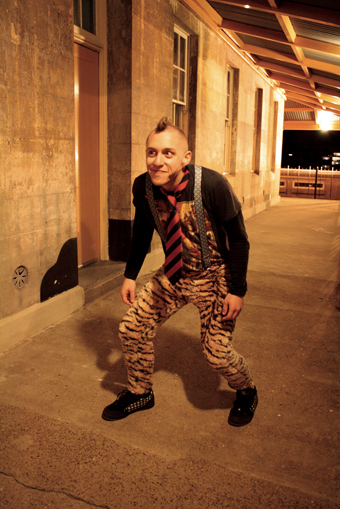dream within a dream, city within a city
caroline wake: tantrum theatre, dreams of a forgotten city

Dean Johnson, Dreams of a Forgotten City
photo Justine Potter
Dean Johnson, Dreams of a Forgotten City
IF NEWCASTLE IS A SORT OF FORGOTTEN CITY—LARGE BUT NOT THAT LARGE, NOT A STATE CAPITAL, AND A SAFE LABOR SEAT SO RARELY THE RECIPIENT OF EITHER STATE OR FEDERAL BRIBES—THEN FORT SCRATCHLEY IS A SORT OF FORGOTTEN CITY WITHIN A FORGOTTEN CITY. BUILT IN 1892 ON A HEADLAND THE AWABAKAL PEOPLE CALL TAHLBIHN, THE FORT’S MOST FAMOUS MOMENT CAME IN 1942, WHEN ITS GUNNERS REPELLED A JAPANESE SUBMARINE THAT ATTACKED NEWCASTLE. SIXTY-EIGHT YEARS LATER IT IS THE SCENE OF SCHOOL EXCURSIONS, THE OCCASIONAL WEDDING AND, TONIGHT, TANTRUM THEATRE’S LATEST PRODUCTION.
Dreams of a Forgotten City proceeds in three parts. To begin with we are split into seven groups of seven, each group and its guide starting at a different point within the walking tour. Our group starts by stumbling upon a young man slumped in a doorway. He asks if we have the time—his watch has broken and as his monologue proceeds it becomes clear that his heart has too, waiting for a sweetheart who might not be coming back. There is another lone man in the marshalling yard, shouting commands and marching. For a moment he reads as a soldier, surrounded by a company of ghosts, then it seems as if he himself is the ghost, then as he continues his increasingly demented march, it is as if we the audience are the ghosts—privy to some sort of secret ritual.
There are plenty of secrets in this space; indeed there are plenty of secret spaces. Standing around the barracks we watch through the windows as a performer enters a room, dances and then seems to disappear. I get a huge fright when he sneaks up behind me and an even bigger one when I realise that there is another group of spectators standing behind him, watching me watching. Later, we find ourselves in their position, enjoying a moment of meta-spectatorship. Further up the hill, a girl in purple taffeta tells us “it seems that we have met before, and laughed before and loved before.” She repeats her actions and movements but in silence; she too seems to be waiting for someone.
The second section starts in the marshalling yard, where we are ordered to split into slightly larger groups. Highlights of this section include a scene on a wooden bridge, under which a small girl and boy are hiding. The performers post messages on scraps of paper between the planks, which spectators read aloud. It is a series of love letters, but alas love is not to be as a woman walks out from under the bridge and away from her childhood sweetheart. (There are perhaps too many whimsical lovers in the piece, as if this were the only type of history to emerge from war.)
In part three, we reassemble in the yard, forming in different groups again (it is starting to feel strangely like school). One of the most satisfying moments of the performance comes when we watch the man who was marching alone woo the girl in purple taffeta. The song “Where or when” in the background includes the lines she was rehearsing earlier and as it ends he presents her with his fob watch. Finally we reconvene in the yard, with the audience around the edge and the performers on a small hill on the other side. One performer sings “We’ll Meet Again” before they walk across the yard to thank us as the evening ends.
There are some lovely moments in Dreams of a Forgotten City, especially as the scenes start to overlap and connect, but there is too much waiting in between. Of course, some waiting is inevitable in a site-specific performance that involves huge logistics. However, the work loses momentum and the audience patience as they stand in the cold wind, waiting—yet again—for the group in front to finish viewing a particular section. Nevertheless, there are some strong performances and the cast of nine feels like a cast of thousands, effectively portraying soldiers, lovers, fathers, mothers and ghosts.
Dreams of a Forgotten City is Tantrum’s latest site-specific work (see my review of The Hour We Knew Nothing of Each Other, RT95, pg10) and the company continues to investigate the intersection of place, space, story and performance. Dreams allows us to rediscover Fort Scratchley—to peer through its windows, nestle in its nooks and crannies and re-imagine its many histories. Most satisfyingly of all, the performance itself is now a part of this history—a dream within a dream about a city within a city.
Tantrum Theatre, Dreams of a Forgotten City, director Brendan O’Connell, dramaturg Rachel Jackett, performers Florence Barrett, Liam Bird, Dean Blackford, Mitchell Bourke, Ben Freeman, Dean Johnson, Kate Neilson, Jasmine Skye Payne, Stephanie Priest; Fort Scratchley, Newcastle, Aug 18-21
RealTime issue #99 Oct-Nov 2010 pg. 39






